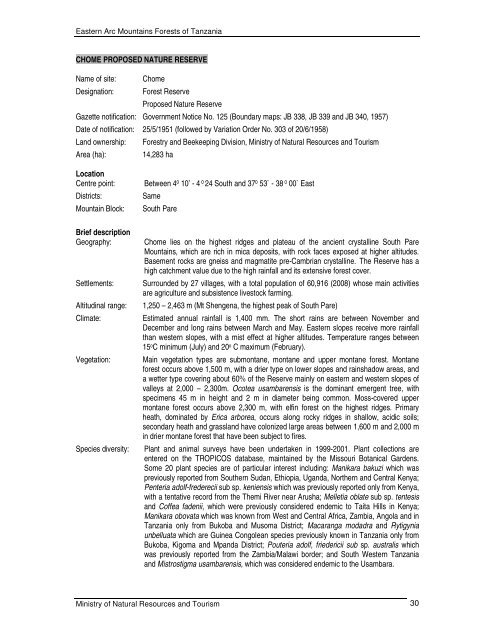eastern arc mountains forests of tanzania - Campaign for the ...
eastern arc mountains forests of tanzania - Campaign for the ...
eastern arc mountains forests of tanzania - Campaign for the ...
You also want an ePaper? Increase the reach of your titles
YUMPU automatically turns print PDFs into web optimized ePapers that Google loves.
Eastern Arc Mountains Forests <strong>of</strong> Tanzania<br />
CHOME PROPOSED NATURE RESERVE<br />
Name <strong>of</strong> site: Chome<br />
Designation: Forest Reserve<br />
Proposed Nature Reserve<br />
Gazette notification: Government Notice No. 125 (Boundary maps: JB 338, JB 339 and JB 340, 1957)<br />
Date <strong>of</strong> notification: 25/5/1951 (followed by Variation Order No. 303 <strong>of</strong> 20/6/1958)<br />
Land ownership: Forestry and Beekeeping Division, Ministry <strong>of</strong> Natural Resources and Tourism<br />
Area (ha): 14,283 ha<br />
Location<br />
Centre point: Between 4 0 10’ - 4 0 24 South and 37 0 53` - 38 0 00` East<br />
Districts: Same<br />
Mountain Block: South Pare<br />
Brief description<br />
Geography: Chome lies on <strong>the</strong> highest ridges and plateau <strong>of</strong> <strong>the</strong> ancient crystalline South Pare<br />
Mountains, which are rich in mica deposits, with rock faces exposed at higher altitudes.<br />
Basement rocks are gneiss and magmatite pre-Cambrian crystalline. The Reserve has a<br />
high catchment value due to <strong>the</strong> high rainfall and its extensive <strong>for</strong>est cover.<br />
Settlements: Surrounded by 27 villages, with a total population <strong>of</strong> 60,916 (2008) whose main activities<br />
are agriculture and subsistence livestock farming.<br />
Altitudinal range: 1,250 – 2,463 m (Mt Shengena, <strong>the</strong> highest peak <strong>of</strong> South Pare)<br />
Climate: Estimated annual rainfall is 1,400 mm. The short rains are between November and<br />
December and long rains between M<strong>arc</strong>h and May. Eastern slopes receive more rainfall<br />
than western slopes, with a mist effect at higher altitudes. Temperature ranges between<br />
15 o C minimum (July) and 20 o C maximum (February).<br />
Vegetation: Main vegetation types are submontane, montane and upper montane <strong>for</strong>est. Montane<br />
<strong>for</strong>est occurs above 1,500 m, with a drier type on lower slopes and rainshadow areas, and<br />
a wetter type covering about 60% <strong>of</strong> <strong>the</strong> Reserve mainly on <strong>eastern</strong> and western slopes <strong>of</strong><br />
valleys at 2,000 – 2,300m. Ocotea usambarensis is <strong>the</strong> dominant emergent tree, with<br />
specimens 45 m in height and 2 m in diameter being common. Moss-covered upper<br />
montane <strong>for</strong>est occurs above 2,300 m, with elfin <strong>for</strong>est on <strong>the</strong> highest ridges. Primary<br />
heath, dominated by Erica arborea, occurs along rocky ridges in shallow, acidic soils;<br />
secondary heath and grassland have colonized large areas between 1,600 m and 2,000 m<br />
in drier montane <strong>for</strong>est that have been subject to fires.<br />
Species diversity: Plant and animal surveys have been undertaken in 1999-2001. Plant collections are<br />
entered on <strong>the</strong> TROPICOS database, maintained by <strong>the</strong> Missouri Botanical Gardens.<br />
Some 20 plant species are <strong>of</strong> particular interest including: Manikara bakuzi which was<br />
previously reported from Sou<strong>the</strong>rn Sudan, Ethiopia, Uganda, Nor<strong>the</strong>rn and Central Kenya;<br />
Penteria adolf-frederecii sub sp. keniensis which was previously reported only from Kenya,<br />
with a tentative record from <strong>the</strong> Themi River near Arusha; Melletia oblate sub sp. tentesis<br />
and C<strong>of</strong>fea fadenii, which were previously considered endemic to Taita Hills in Kenya;<br />
Manikara obovata which was known from West and Central Africa, Zambia, Angola and in<br />
Tanzania only from Bukoba and Musoma District; Macaranga modadra and Rytigynia<br />
unbelluata which are Guinea Congolean species previously known in Tanzania only from<br />
Bukoba, Kigoma and Mpanda District; Pouteria adolf, friedericii sub sp. australis which<br />
was previously reported from <strong>the</strong> Zambia/Malawi border; and South Western Tanzania<br />
and Mistrostigma usambarensis, which was considered endemic to <strong>the</strong> Usambara.<br />
Ministry <strong>of</strong> Natural Resources and Tourism 30


